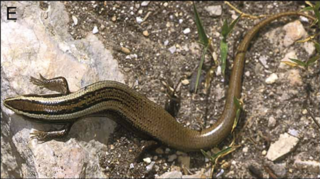
Sphaerodactylus is a genus of geckos from the Americas that are distinguished from other Gekkota by their small size, by their round, rather than vertical, eye pupils, and by each digit terminating in a single, round adhesive pad or scale, from which their name is derived. All species in this genus are rather small, but two species, S. ariasae and S. parthenopion, are tiny, and – with a snout-vent length of about 1.6 cm (0.63 in) – the smallest reptiles in the world.

Leiocephalidae, also known as the curlytail lizards or curly-tailed lizards, is a family of iguanian lizards restricted to the West Indies. One of the defining features of these lizards is that their tail often curls over. They were previously regarded as members of the subfamily Leiocephalinae within the family Tropiduridae. There are presently 29 known species, all in the genus Leiocephalus.

Mabuya is a genus of long-tailed skinks restricted to species from various Caribbean islands. They are primarily carnivorous, though many are omnivorous. The genus is viviparous, having a highly evolved placenta that resembles that of eutherian mammals. Formerly, many Old World species were placed here, as Mabuya was a kind of "wastebasket taxon". These Old World species are now placed in the genera Chioninia, Eutropis, and Trachylepis. Under the older classification, the New World species were referred to as "American mabuyas", and now include the genera Alinea, Aspronema, Brasiliscincus, Capitellum, Maracaiba, Marisora, Varzea, and Copeoglossum.

Scelotes is a genus of small African skinks.

Tropidosaura is a genus of wall lizards of the family Lacertidae. The genus is endemic to southern Africa.

The fauna of Puerto Rico is similar to other island archipelago faunas, with high endemism, and low, skewed taxonomic diversity. Bats are the only extant native terrestrial mammals in Puerto Rico. All other terrestrial mammals in the area were introduced by humans, and include species such as cats, goats, sheep, the small Indian mongoose, and escaped monkeys. Marine mammals include dolphins, manatees, and whales. Of the 349 bird species, about 120 breed in the archipelago, and 47.5% are accidental or rare.
The Caribbean bioregion is a biogeographic region that includes the islands of the Caribbean Sea and nearby Atlantic islands, which share a fauna, flora and mycobiota distinct from surrounding bioregions.

Diploglossidae is a family of anguimorph lizards native to the Americas, with most genera being endemic to Hispaniola. Most members of this family are known as galliwasps. They were formerly considered a subfamily of Anguidae, but genetic evidence has shown them to be less closely related to other members of Anguidae than Anniellidae is.

Spondylurus powelli, the Anguilla Bank skink, was discovered in the Caribbean with 20 other reptile species and was immediately listed as an endangered species. The population of this lizard has been decreasing due to the introduction of the mongoose, which was originally imported to control rats in sugarcane fields, and now is an invasive species to the Caribbean Islands. Many of the newly added skink species discovered along with S. powelli are facing extinction for the same reason. Skinks are unique and perhaps at a disadvantage among lizards as they produce a human-like placenta and have live birth. The average gestation period is suggested at one year and may be the cause for the skinks being an easy target to the mongoose, since they are larger and slower when pregnant. Other types of human activity, along with the deforestation in the Caribbean, are thought to have decreased overall species numbers, as well.
Capitellum is a genus of skinks. Species were previously placed in the genus Mabuya. All species in this genus are considered possibly extinct, due to a lack of recent sightings but the presence of potential refuges.

Marisora is a genus of skinks. They are found in Mexico, Central America and some Caribbean islands.

Mabuyinae is a subfamily of skinks within the family Scincidae. The genera in this subfamily were previously found to belong the Mabuya group in the large subfamily Lygosominae.
Spondylurus haitiae, the Hispaniolan four-lined skink, is a species of skink endemic to Haiti. It is only known from its type locality where it was last collected at around 1857–1858. Considering the extensive field work in the area and the loss of suitable habitat, it is likely that this species is extinct.
The Lesser Virgin Islands skink is a species of skink found in the United States Virgin Islands and the British Virgin Islands.
Spondylurus sloanii, also known commonly as Sloane's skink or the Virgin Islands bronze skink, is a species of lizard in the family Scincidae. The species is native to the United States Virgin Islands and the British Virgin Islands.

Caribicus is a genus of diploglossid lizards endemic to the island of Hispaniola in the Caribbean, in both the Dominican Republic and Haiti.











